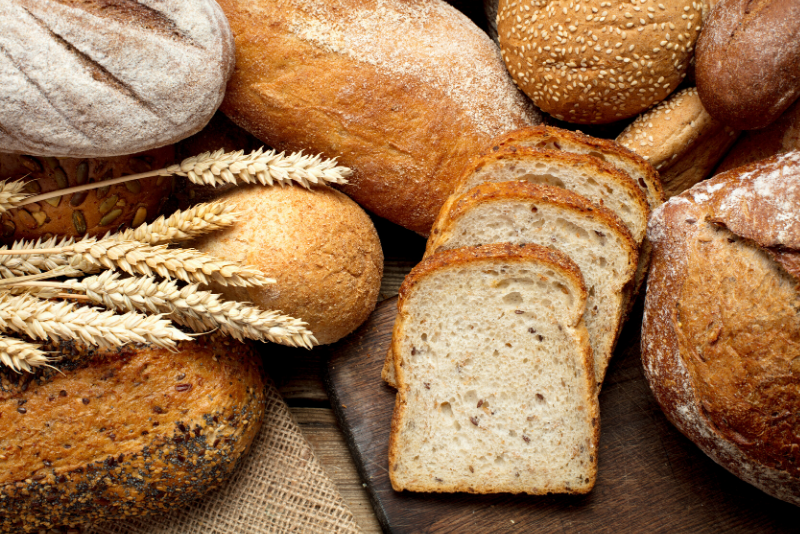Learn why bread should be back on your shopping list and how to pick the healthiest loaf.
Referred to as the “staff of life” in the Bible, bread has been, literally, served for ages. Interestingly, darker grains were often eaten by peasants, with refined grains going to royalty. Lower classes didn’t have the money or fancy equipment to process wheat by separating out the grain’s various components to make bread look white and make it easy to digest. Yet isn’t it ironic how these days, a healthier and “cleaner” bread would contain more whole grains and be darker in color, less processed and have a desirable high-fiber content?
But of all the food groups, there is no one that has been more maligned in the media than the “bread group.” Bread has been bashed by a long list of diet followers, including Atkins, Stillman, Whole30, GM Diet and, more recently, paleo and keto plans – just to name a few.
As a nutrition consultant, I have seen scores of patients and heard testimonies from friends and relatives that swore that they lost the most weight when they swore off bread.
Poor bread. So loved. So hated. So often talked about and so misunderstood. But ditching carbs like bread could result in serious consequences.

The Risks of Going Bread Free
According to Yanni Papanikolaou, vice president at Nutritional Strategies, a consulting firm based in Kalamazoo, Michigan, “Avoiding breads, cereals and other grains that are fortified with folic acid can be dangerous for women of childbearing age.” Since the mandatory fortification of grains in 1998 by the FDA, there’s been a significant decline in babies born with neural tube defects, he says.
Moreover, researchers at the Centers for Disease Control and Prevention found that since folic acid fortification began, approximately 1,300 babies are born each year without a neural tube defect who might otherwise have been affected.
Papanikolaou points out, “A study published in Birth Defects Research in 2018 showed that women with restricted carbohydrate intake were 30% more likely to have an infant with a neural tube defect. Even with current levels of grain consumption in the U.S., we saw that about 28 million American adults are below recommendations for folate intake. If you remove all fortified grains from the diet, the number of adults not meeting recommendations for folate increases from 28 million to 111 million.”
Therefore, severe low-carb diets, especially for women who are thinking of getting pregnant, could bring more than weight loss. So perhaps it’s time to take a closer look at bread before we continue to devalue a food that used to be a dietary staple.
Bread Nutrition Facts
An average slice, or ounce, of bread contains around:
80 calories.
15 grams of carbohydrates (about the same amount in a small serving of fruit).
3 grams of protein.
These numbers may need to be quadrupled, however, if you’re biting into a bagel or hero roll. For some people – like me – a slice or two of bread at a meal brings satisfaction, physically and emotionally. Whole grains and fiber help you to feel full and satiated, and carbs can raise serotonin levels to help boost your mood.
The best bread for you depends on your own particular needs. My favorite bread, for example, wears a lengthy list of more that 25 ingredients comprised of organic grains and seeds. If you’re looking for a shorter list, just be sure whole grains (like whole wheat) are listed first, and keep sugar, sodium and fat content in mind. Some breads will provide more fiber than others, and some are lighter in color.
Other examples of whole grains include:
Quinoa – technically a seed but often referred to as a grain.
Oats.
Brown rice.
Polenta (which is made from corn).
Barley.
Amaranth.
Bulgur.
Buckwheat.
Kasha (toasted buckwheat).
Spelt.
Farro.
Millet.
Whichever you choose, remember that the calories you end up with may be more of a reflection of what you put on your bread, like butter, mayo and thick fillings, since the company bread keeps may be more of a calorie culprit than the bread itself.
Whole Grain Bread
A whole grain is the entire seed — the bran, the endosperm and the germ. Whole grains contain key nutrients that offer bread with benefits including B vitamins and trace minerals (iron, zinc, copper and magnesium). The fiber content of whole grain breads helps to keep you satiated for a longer period of time, so ditching bread at your meal could mean giving into a mid-meal snack attack of foods that are less nutritional and higher in calories. Be sure to flip your package over and look for whole grains as a first ingredient on the ingredient list.
Multigrain Bread
The term “multi” means many – so your multigrain bread may contain many different types of grains, but it doesn’t necessarily mean that any of these are whole grains. You should be looking for breads wearing a label that shows a whole grain or whole wheat as a first ingredient. “Wheat flour” as a first ingredient is not the same and could be void of value.
Sprouted Bread
Sprouted grain bread is made from kernels that have been sprouted, grounded and baked into bread. They usually contain a little more protein and less fat than regular versions but, in general, the fat content of bread is not going to be significant unless you’re choosing croissants. Sprouted bread is believed to be more easily digested since the sprouting process breaks down some of the carbs ahead of time. Although sprouted grain breads may have less gluten, those who are gluten sensitive or intolerant would need to avoid sprouted bread unless stated “gluten-free” on the labels and it’s produced by a manufacturer you trust.
Gluten-Free Bread
Gluten is a protein found in grains that help make the dough in bread more elastic. For those who are unable to tolerate gluten, grains like wheat, barley, rye, triticale and sometimes oats (unless labeled otherwise) need to be avoided.
Gluten-free whole grains and flours that can be eaten include:
Amaranth.
Arrowroot.
Buckwheat.
Corn and cornmeal.
Flax.
Brown and wild rice.
Quinoa.
Millet.
Sorghum.
Teff.
Gluten-free flours: rice, soy, corn, potato, bean.
The gluten content of bread has nothing to do with its calories or nutrient profile. Gluten-free breads are often lower in fiber, not fortified with B vitamins and can be higher in fat than regular whole grains. Gluten-free breads may weigh heavier on your wallet too, costing more than an average gluten-laden loaf, so unless you have a medical reason for going gluten free, you might want to give this bread a pass.
White Whole Wheat
White bread lovers can feel good in knowing that, similar to whole-wheat bread, white whole-wheat bread is also made with whole grains. The difference between them is that white whole-wheat bread is made from white wheat, bringing it a milder flavor, fluffier texture and lighter color. The whole wheat bread we’re used to seeing is made from red wheat, contributing a darker color and coarser texture. Unlike white whole-wheat bread, basic white bread is made from refined grains and is more highly processed, thereby stripping away some important parts of the grain and their related nutrients.
Enriched or Fortified Bread
Don’t freak out if your child refuses to eat whole grain breads. Even the USDA’s dietary guidelines suggests that at least half of our grains should come from whole grains. So although regular white bread may lack fiber, many are enriched or fortified. You can still fit in whole grains through cereals, pastas and an array of side dishes.
“Enriched” flour has had many of the vitamins and minerals that were originally present in the grain and stripped away. Then they are replaced after the food processing procedure. “Fortified” flour, on the other hand, has had new vitamins and minerals placed into it, meaning those that weren’t naturally present in the grain prior to processing. As mentioned, fortification of grains and flour with folic acid has significantly reduced the incidence of neural tube defects in children.
Bonnie is a contributor for US News & World Report. Her story also appeared here.


